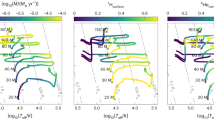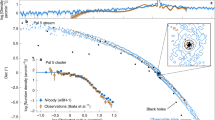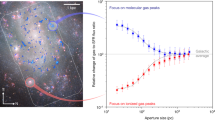Abstract
There are two dominant models of how stars form. Under gravitational collapse, star-forming molecular clumps, of typically hundreds to thousands of solar masses (M⊙), fragment into gaseous cores that subsequently collapse to make individual stars or small multiple systems1,2,3. In contrast, competitive accretion theory suggests that at birth all stars are much smaller than the typical stellar mass (∼0.5M⊙), and that final stellar masses are determined by the subsequent accretion of unbound gas from the clump4,5,6,7,8. Competitive accretion models interpret brown dwarfs and free-floating planets as protostars ejected from star-forming clumps before they have accreted much mass; key predictions of this model are that such objects should lack disks, have high velocity dispersions, form more frequently in denser clumps9,10,11, and that the mean stellar mass should vary within the Galaxy8. Here we derive the rate of competitive accretion as a function of the star-forming environment, based partly on simulation12, and determine in what types of environments competitive accretion can occur. We show that no observed star-forming region can undergo significant competitive accretion, and that the simulations that show competitive accretion do so because the assumed properties differ from those determined by observation. Our result shows that stars form by gravitational collapse, and explains why observations have failed to confirm predictions of the competitive accretion model.
This is a preview of subscription content, access via your institution
Access options
Subscribe to this journal
Receive 51 print issues and online access
$199.00 per year
only $3.90 per issue
Buy this article
- Purchase on Springer Link
- Instant access to full article PDF
Prices may be subject to local taxes which are calculated during checkout
Similar content being viewed by others
References
Shu, F. H., Adams, F. C. & Lizano, S. Star formation in molecular clouds—observation and theory. Annu. Rev. Astron. Astrophys. 25, 23–81 (1987)
Padoan, P. & Nordlund, Å. The stellar initial mass function from turbulent fragmentation. Astrophys. J. 576, 870–879 (2002)
Larson, R. B. Thermal physics, cloud geometry and the stellar initial mass function. Mon. Not. R. Astron. Soc. 359, 211–222 (2005)
Bonnell, I. A., Bate, M. R. & Zinnecker, H. On the formation of massive stars. Mon. Not. R. Astron. Soc. 298, 93–102 (1998)
Bonnell, I. A., Bate, M. R., Clarke, C. J. & Pringle, J. E. Competitive accretion in embedded stellar clusters. Mon. Not. R. Astron. Soc. 323, 785–794 (2001)
Bonnell, I. A., Clarke, C. J., Bate, M. R. & Pringle, J. E. Accretion in stellar clusters and the initial mass function. Mon. Not. R. Astron. Soc. 324, 573–579 (2001)
Bonnell, I. A., Vine, S. G. & Bate, M. R. Massive star formation: nurture, not nature. Mon. Not. R. Astron. Soc. 349, 735–741 (2004)
Bate, M. R. & Bonnell, I. A. The origin of the initial mass function and its dependence on the mean Jeans mass in molecular clouds. Mon. Not. R. Astron. Soc. 356, 1201–1221 (2005)
Bate, M. R., Bonnell, I. A. & Bromm, V. The formation mechanism of brown dwarfs. Mon. Not. R. Astron. Soc. 332, L65–L68 (2002)
Bate, M. R., Bonnell, I. A. & Bromm, V. The formation of a star cluster: predicting the properties of stars and brown dwarfs. Mon. Not. R. Astron. Soc. 339, 577–599 (2003)
Mohanty, S., Jayawardhana, R. & Basri, G. The T Tauri phase down to nearly planetary masses: echelle spectra of 82 very low mass stars and brown dwarfs. Astrophys. J. 626, 498–522 (2005)
Krumholz, M. R., McKee, C. F. & Klein, R. I. Bondi-Hoyle accretion in a turbulent medium. Astrophys. J. (in the press); preprint at http://arXiv.org/astro-ph/0510410 (2005)
McKee, C. F. & Tan, J. C. The formation of massive stars from turbulent cores. Astrophys. J. 585, 850–871 (2003)
Padoan, P., Kritsuk, A., Norman, M. L. & Nordlund, Å. A solution to the pre-main-sequence accretion problem. Astrophys. J. Lett. 622, L61–L64 (2005)
Bertoldi, F. & McKee, C. F. Pressure-confined clumps in magnetized molecular clouds. Astrophys. J. 395, 140–157 (1992)
Fiege, J. D. & Pudritz, R. E. Helical fields and filamentary molecular clouds—I. Mon. Not. R. Astron. Soc. 311, 85–104 (2000)
Edgar, R. & Clarke, C. The effect of radiative feedback on Bondi-Hoyle flow around a massive star. Mon. Not. R. Astron. Soc. 349, 678–686 (2004)
Ruffert, M. & Arnett, D. Three-dimensional hydrodynamic Bondi-Hoyle accretion. 2: Homogeneous medium at mach 3 with γ = 5/3. Astrophys. J. 427, 351–376 (1994)
Larson, R. B. Turbulence and star formation in molecular clouds. Mon. Not. R. Astron. Soc. 194, 809–826 (1981)
Motte, F., Andre, P. & Neri, R. The initial conditions of star formation in the ρ Ophiuchi main cloud: wide-field millimeter continuum mapping. Astron. Astrophys. 336, 150–172 (1998)
Testi, L. & Sargent, A. I. Star formation in clusters: A survey of compact millimeter-wave sources in the Serpens core. Astrophys. J. Lett. 508, L91–L94 (1998)
Johnstone, D., Fich, M., Mitchell, G. F. & Moriarty-Schieven, G. Large area mapping at 850 microns. III. Analysis of the clump distribution in the Orion B molecular cloud. Astrophys. J. 559, 307–317 (2001)
Plume, R., Jaffe, D. T., Evans, N. J., Martin-Pintado, J. & Gomez-Gonzalez, J. Dense gas and star formation: Characteristics of cloud cores associated with water masers. Astrophys. J. 476, 730–749 (1997)
Klessen, R. S. & Burkert, A. The formation of stellar clusters: gaussian cloud conditions I. Astrophys. J. Suppl. 128, 287–319 (2000)
Klessen, R. S. & Burkert, A. The formation of stellar clusters: gaussian cloud conditions II. Astrophys. J. 549, 386–401 (2001)
Bate, M. R., Bonnell, I. A. & Bromm, V. The formation of close binary systems by dynamical interactions and orbital decay. Mon. Not. R. Astron. Soc. 336, 705–713 (2002)
Beuther, H. & Schilke, P. Fragmentation in massive star formation. Science 303, 1167–1169 (2004)
Quillen, A. C. et al. Turbulence driven by outflow-blown cavities in the molecular cloud of NGC 1333. Astrophys. J. (in the press); preprint at http://arXiv.org/astro-ph/0503167 (2005)
Cho, J. & Lazarian, A. Compressible magnetohydrodynamic turbulence: mode coupling, scaling relations, anisotropy, viscosity-damped regime and astrophysical implications. Mon. Not. R. Astron. Soc. 345, 325–339 (2003)
Kramer, C. & Winnewisser, G. A molecular survey of the dark cloud L 1495 in Taurus. Astron. Astrophys. Suppl. 89, 421–428 (1991)
Acknowledgements
We thank R. T. Fisher for discussions and P. Padoan for comments. This work was supported by grants from NASA through the Hubble Fellowship, GSRP and ATP programmes, by the NSF, and by the US DOE through the Lawrence Livermore National Laboratory. Computer simulations for this work were performed at the San Diego Supercomputer Center (supported by the NSF), the National Energy Research Scientific Computer Center (supported by the US DOE), and Lawrence Livermore National Laboratory (supported by the US DOE). M.R.K. is a Hubble Fellow.
Author information
Authors and Affiliations
Corresponding author
Ethics declarations
Competing interests
Reprints and permissions information is available at npg.nature.com/reprintsandpermissions. The authors declare no competing financial interests.
Supplementary information
Supplementary Notes
This file contains supplementary discussion and equations. (PDF 36 kb)
Rights and permissions
About this article
Cite this article
Krumholz, M., McKee, C. & Klein, R. The formation of stars by gravitational collapse rather than competitive accretion. Nature 438, 332–334 (2005). https://doi.org/10.1038/nature04280
Received:
Accepted:
Issue Date:
DOI: https://doi.org/10.1038/nature04280
This article is cited by
-
Origin and dynamical evolution of young mass-segregated clusters
Astrophysics and Space Science (2009)
-
Star and planet-formation with ALMA: an overview
Astrophysics and Space Science (2008)
-
Astrophysics in 2006
Space Science Reviews (2007)
-
Condensates in the Cosmos: Quantum Stabilization of the Collapse of Relativistic Degenerate Stars to Black Holes
Foundations of Physics (2007)
-
The critical role of disks in the formation of high-mass stars
Nature (2006)
Comments
By submitting a comment you agree to abide by our Terms and Community Guidelines. If you find something abusive or that does not comply with our terms or guidelines please flag it as inappropriate.



